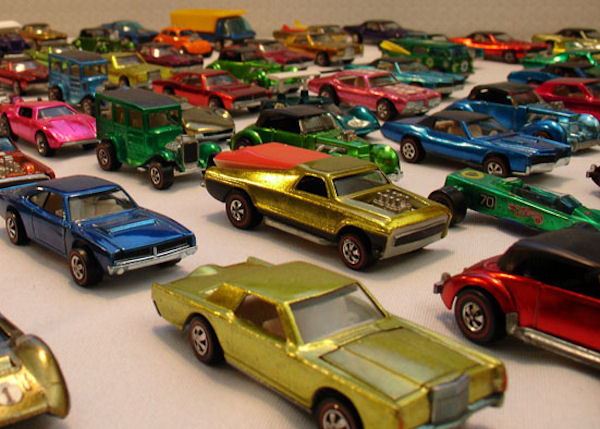
Nowadays, companies make millions of dollars a year selling miniature versions of America’s favorite form of transportation: the automobile. Hot Wheels specifically creates dozens of its own custom designs each year that are eagerly gobbled up by collectors. Meanwhile, children bug and cajole their parents into buying the latest Hot Wheels tracks with gravity-defying loops and twists.
It’s easy to see why toy cars would be such a big hit with boys, but where did it all start? These iconic toys have their origins in Matchbox cars, designed by Jack Odell in 1953 for his… daughter? Yup! The school his daughter was attending would only allow them to bring toys that could fit inside of a matchbox. So he designed a miniature version of his company’s toy steamroller. Matchbox was the best-selling die-cast car in the world by 1968.
That’s also the year that Matchbox got some serious competition: Hot Wheels. The American company’s (did I mention this phenomenon started in the UK? It started in the UK…) cars had low-friction “racing” wheels on their cars. This allowed for extra speedy passes on the available Hot Wheels racing tracks. Matchbox had neither of these, and had some catching up to do.
Matchbox never did manage to catch Hot Wheels. As is all too common, Hot Wheels’ parent company Mattel ended up buying out Matchbox’s then-owner Tyco Toys. So yeah, if you’re trying to be a rebel by buying Matchbox over Hot Wheels for your kids? Not so much. Nowadays Matchbox specializes mainly in faithful recreations of existing autos while Hot Wheels focuses on fantasy cars and track sets. See? Everyone wins!
Except for Micro Machines. They’re dead.
You didn’t think I was going to leave out Micro Machines, did you? Micro Machines was like the stunted third child that everyone begrudgingly admits to loving before ultimately ignoring them. Introduced in 1986, Micro machines emulated its bigger brothers, but in a smaller scale. The diminutive cars came in at around half the size of a comparable Matchbox.
Micro Machines sold more than Hot Wheels and Matchbox for the first few years of the company’s existence, its popularity no-doubt spurred on by the vocal gymnastics of John Moschitta. The company was sold to Hasbro in the 90’s and the original line of toys was discontinued. What was left didn’t sell as well as hoped and largely spelled doom for the fledgling line of micro-toys. The line was discontinued in 2006.

